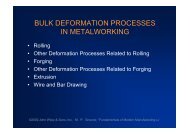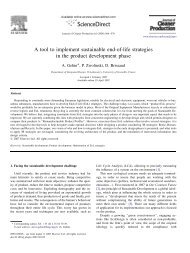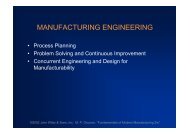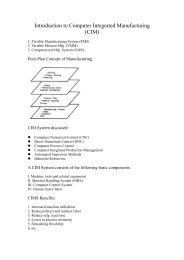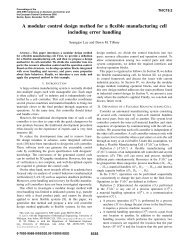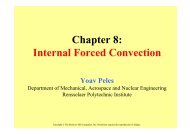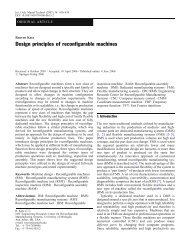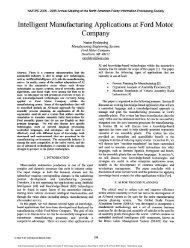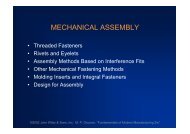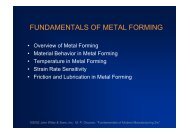A real-time predictive maintenance system for machine systems
A real-time predictive maintenance system for machine systems
A real-time predictive maintenance system for machine systems
You also want an ePaper? Increase the reach of your titles
YUMPU automatically turns print PDFs into web optimized ePapers that Google loves.
International Journal of Machine Tools & Manufacture 44 (2004) 759–766www.elsevier.com/locate/ijmactoolA <strong>real</strong>-<strong>time</strong> <strong>predictive</strong> <strong>maintenance</strong> <strong>system</strong> <strong>for</strong> <strong>machine</strong> <strong>system</strong>sDheeraj Bansal a, , David J. Evans b , Barrie Jones aa Mechanical Engineering Department, School of Engineering and Applied Science, Control and Dynamics Research Group,Aston University, Birmingham B4 7ET, UKb Neural Computing Research Group, Aston University, Birmingham B4 7ET, UKReceived 27 October 2003; received in revised <strong>for</strong>m21 January 2004; accepted 2 February 2004AbstractThis paper describes a novel <strong>real</strong>-<strong>time</strong> <strong>predictive</strong> <strong>maintenance</strong> <strong>system</strong> <strong>for</strong> <strong>machine</strong> <strong>system</strong>s based upon a neural networkapproach. The ability of a neural network to learn non-linear mapping functions has been used <strong>for</strong> the prediction of <strong>machine</strong><strong>system</strong> parameters using the motion current signature. This approach avoids the need <strong>for</strong> costly measurement of <strong>system</strong> parameters.Unlike many neural network based condition monitoring <strong>system</strong>s, this approach is validated in an off-line proof of conceptprocedure, using data from an experimental test rig providing conditions typical of those used on production <strong>machine</strong>s. Theexperiment aims to classify five distinct motor loads using the motion current signature, irrespective of changing tuning parameters.Comparison of the predicted and actual loads shows good agreement. Generation of data covering all anticipated<strong>machine</strong> states <strong>for</strong> neural network training, using a production <strong>machine</strong>, is impractical, and the use of simulated data, generatedby an experimentally validated simulation model, is effective. This paper demonstrates the underlying structure of the developedsimulation model.# 2004 Elsevier Ltd. All rights reserved.Keywords: Neural network; Motion current signature; Machine parameter; Predictive <strong>maintenance</strong>1. IntroductionMuch emphasis has been given to the research anddevelopment of high speed <strong>machine</strong> <strong>system</strong>s possessinghigh levels of programmability and reconfigurability.Motion cycle demands in such <strong>machine</strong>s are high;motors and drives are required to per<strong>for</strong>m underdemanding conditions, hence the need <strong>for</strong> a preventive<strong>maintenance</strong> <strong>system</strong>. Modern <strong>machine</strong>s typically usesome <strong>for</strong>m of direct current (DC) motor and the processdescribed is based upon such motors.The DC motor is one of the first <strong>machine</strong>s devised toconvert electrical power into mechanical power. Recentimprovements in DC <strong>machine</strong>s, and specifically theemergence of the brushless motor have lead to its wideusage due to its high torque and small size when comparedto induction motors. Corresponding author. Tel.: +44-121-359-3611; fax: +44-121-333-5809.E-mail address: bansald@aston.ac.uk (D. Bansal).The need <strong>for</strong> new high-per<strong>for</strong>mance motors, withhighly sophisticated capabilities, has produced anabundance of new types and sizes of DC motor. Nowadays,DC motors are widely used in many <strong>machine</strong>applications; with this there is a need <strong>for</strong> highreliability supported by an effective <strong>maintenance</strong> <strong>system</strong>.Recent studies have demonstrated that the techniqueof <strong>predictive</strong> <strong>maintenance</strong> approach can ensurehigh reliability and per<strong>for</strong>mance [1,5–7,10,16,20].This paper introduces an effective, <strong>real</strong>-<strong>time</strong>, <strong>predictive</strong><strong>maintenance</strong> <strong>system</strong> based on the motion currentsignature. The aimof the proposed <strong>system</strong>is to localizeand detect abnormal electrical conditions in order topredict mechanical abnormalities that indicate, or maylead to the failure of the motor [12,13].Conventional techniques require an accurate mathematicalmodel in order to predict the dynamic behaviorin response to a command input [2–4,8,9,11,15].This requires that <strong>system</strong>parameters such as load,backlash and torque are accurately known. Tracking ofthe <strong>system</strong>parameter changes during the operation0890-6955/$ - see front matter # 2004 Elsevier Ltd. All rights reserved.doi:10.1016/j.ijmachtools.2004.02.004
760 D. Bansal et al. / International Journal of Machine Tools & Manufacture 44 (2004) 759–766NomenclatureK pK iK dP cmdP AP errP errpP intP diffV ffV gainI gainK ffvK ffaV cmdV AV errV errpV errintV errdiffI cmdT cmdJ LG TF TJ MK tF TmT sposition proportional gainposition integral gainposition differential gainposition commandactual positionposition error (current sample)position error (previous sample)position error integralposition error differentialshaft velocityvelocity proportional gainvelocity integral gainvelocity feed-<strong>for</strong>ward gainacceleration feed-<strong>for</strong>ward gainvelocity commandactual velocityvelocity error (current sample)velocity error (previous sample)velocity error integralvelocity error differentialcurrent commandtorque commandload inertiaexternal torquefriction torquemotor inertiamotor torque constantmotor friction torque<strong>time</strong> slicenecessitates costly instrumentation, which is difficult tojustify on a production <strong>machine</strong> <strong>system</strong>. The approachpresented here allows deviations fromthe normaldynamic behavior to be predicted accurately basedupon the interpretation of the motor current characteristic.The <strong>system</strong>uses a neural network which learnsthe non-linear mapping function between <strong>system</strong> parametersand motion current signature and avoids theneed <strong>for</strong> costly measurement of <strong>system</strong> parameters. Theneural network has been shown to be an effective technique<strong>for</strong> per<strong>for</strong>ming motor fault detection [14,17–19].Successful implementation of neural networks <strong>for</strong>motor fault detection and diagnosis, up to an accuracyof more than 90%, has been achieved [18].A fundamental requirement <strong>for</strong> the successfulimplementation of a neural network is the availability ofrelevant, in<strong>for</strong>mation-rich training data. This applicationrequires <strong>machine</strong> parameters to be varied to coverall anticipated <strong>machine</strong> conditions; which ensures thatany parameter variation can be interpolated [21–23].While an ideal solution would be to utilize training datafrom a <strong>real</strong> production <strong>system</strong>, this is impractical <strong>for</strong> anumber of reasons:1. a large number of sensors would be required tocollect data relevant to all <strong>machine</strong> parameters;2. <strong>machine</strong> faults are rare and unlikely to occur;3. it is impractical to scan the entire range of <strong>machine</strong>operations.This motivates an alternative approach <strong>for</strong> developinga <strong>system</strong>which generates the training data usingsimulation models. Simulation modelling is a valuablealternative provided that the model is fully validatedagainst a <strong>real</strong> production <strong>machine</strong> [13]. The model canbe used to generate the training data covering allanticipated <strong>machine</strong> conditions. The simulation modeldeveloped <strong>for</strong> this <strong>system</strong>is the result of a jointUniversity and Rockwell Automation research programme.Initially, the primary objective was to developa tool that would be used to optimize the size andselection configuration <strong>for</strong> motors, drives and <strong>system</strong>s[24–33]. Enhancements were added to provide a
D. Bansal et al. / International Journal of Machine Tools & Manufacture 44 (2004) 759–766 761capability <strong>for</strong> simulation and advanced analysis, incorporatingmodels <strong>for</strong> mechanical aspects such as resonanceand backlash.The authors anticipate that the neural networktrained using the training data generated froma validatedsimulation model will have the same level ofcapability as a neural network trained using the trainingdata froma <strong>real</strong> <strong>machine</strong>.Proof of concept is there<strong>for</strong>e carried out with a simplifiedexperimental setup, which is representative of aproduction <strong>machine</strong> axis.2. Proof of conceptThe experiment aimed to classify five distinct motorloads given the motion current signature. The p-gainwas varied from0.1 to 0.3, in steps of 0.01, and v-gainwas varied from5.0 to 15.0, in increments of 1.00. Fivereadings of motion signature were taken per configurationper p-gain per v-gain. In total, 5000 signatureswere collected with a sample size of 900.The data were divided into three groups: trainingdata (1/2 patterns), validation data (1/6 patterns) andtesting data (1/3 patterns). All the groups were normalizedto zero mean and unit variance. Principalcomponent analysis (PCA) [34] was used <strong>for</strong> featureextraction.The eigen-values were arranged in descending order,and the plot of the eigen-value against its rank wasgenerated (Fig. 1). This plot can primarily be used tolocate the number of principal components where‘‘large’’ eigen-values cease and ‘‘small’’ eigen-valuesbegin [36]. The aimwas to identify k principal componentswhose inclusion returns sufficient in<strong>for</strong>mation.Fig. 1 highlights three such points (4, 10 and 14) wherethere was a noticeable step in the value of eigen-value.The cumulative contribution of in<strong>for</strong>mation by the first4 PCs to the data was 60% and hence it was not consideredagainst 10 with a contribution of 85% and 14with a contribution of 96%. The analysis with 14 principalcomponents was adopted. This reduced thedimensionality of data from 900 to 14.A multi-layer perceptron (MLP) with a soft-maxactivation function, was trained using scaled conjugategradient (SCG) optimization [34,35]. Early stoppingregularization was used to avoid over-fitting and numberof hidden units was varied from5 to 50 in steps of1 in order to access model order. The minimum validationerror (obtained by using validation data set ontrained neural network) was plotted against the numberof hidden units in the MLP (Fig. 2). The plot indicatedthat error was a minimum <strong>for</strong> 15 hidden units.Hence, a neural network of 14 inputs, 15 hiddenunits and five outputs (1-of-N coding) was used. Eachoutput of the neural network corresponded to a classwhich represented a load (Table 1).A confusion matrix was used to evaluate the per<strong>for</strong>manceof the classifier [34,35]. A matrix showing therelation between true and predicted classes was generated.Diagonal entries of the matrix indicate the correctclassifications and the off diagonal entries show misclassifications.The rows of the matrix represent thetrue classes and the columns represent the predictedclasses.The response of the neural network to the test datawas obtained and the confusion matrix was plotted(Table 2). The confusion matrix showed 97.59% correctclassification <strong>for</strong> the test data. The off diagonal entriesshowed that 40 out of 1662 samples were misclassified.A graph of correct classification percentage <strong>for</strong> a rangeof loads is shown, Fig. 3. Fig. 3 shows that all the signaturesof loads 2 and 4 were correctly classified. Thisis supported by all zero off diagonal entries in rows 2and 4 of the confusion matrix.Fig. 1. Plot of eigen-values vs. number of PCs. Fig. 2. Plot of validation error vs. number of hidden units.
762 D. Bansal et al. / International Journal of Machine Tools & Manufacture 44 (2004) 759–766Table 1The relationship between shaft masses and classesDescription Class 1-of-N codingNo load (shaft only) 1 10000Small þ shaft 2 01000Smooth þ shaft 3 00100Big mass þ shaft 4 00010Cog þ shaft 5 00001Table 2Confusion matrix using test dataPredicted classes1 2 3 4 5Class 1 295 13 0 0 0Class 2 0 346 0 0 0Class 3 0 1 314 19 0Class 4 0 0 0 322 0Class 5 0 0 0 7 345indicate a borderline case between class 2, 3 and 4.Similarly, the probabilities <strong>for</strong> all the misclassificationswere analyzed and were found to be the borderlinecases. This justifies further work to improve the process.The high value (97.59%) of correct classificationindicates that the neural network based approach can usethe motion current signature <strong>for</strong> predicting the <strong>machine</strong>parameters. However, the concept has been proved byclassifying only inertia as a <strong>system</strong>parameter.Future work lies in identifying other parameters tobe classified using the motion current signature.Additionally, the training data requirement increasesexponentially as the number of <strong>system</strong> parameters tobe classified increases. This multi-fold training datarequirement can be fulfilled with the use of a simulationmodel. Thus, the next step was to design the simulationmodel which can map the <strong>system</strong> parameters tothe motion current signature.The probabilities of the misclassifications of loads 1,3 and 5 were analyzed and were found to be the borderlinecases between the predicted and the true loads.For example, the classifier assigns a probability to thesample <strong>for</strong> each of the five classes. The sum of all theprobabilities is maintained to be 1, due to the use ofthe soft-max activation function in the MLP. The sampleis then classified as a sample of class x, if its probability<strong>for</strong> class x is maximum. A significant differencebetween the highest and the second-highest value of theprobability indicates a satisfactory classification [35].For instance, one of the samples of class 4 was foundto have a probability of 0.07 and 0.93 <strong>for</strong> class 3 and 4,respectively. This indicates a satisfactory classificationof this sample to class 4 due to a large differencebetween the probabilities of class 3 (0.07) and class 4(0.93). However, the sample of class 3, which was misclassifiedas class 2 (row 3 and column 2 of Table 2),had the probability of 0.38, 0.35 and 0.27 <strong>for</strong> class 2, 3and 4, respectively. These values of probability clearlyFig. 3.Percentage of correct load type classification.3. The simulation modelThe simulation model generates the motor currentand velocity characteristics on the basis of <strong>system</strong>parameters,and is capable of modelling a fault conditionwhich cannot be generated in an on-line environment.As such, the model will be used to provide the mappingof <strong>system</strong> parameters and the current-<strong>time</strong> characteristic<strong>for</strong> all anticipated motor conditions. Themapping will then be used to generate training data <strong>for</strong>the neural network.3.1. Block diagram of simulation modelThe simulation model is of a closed loop <strong>for</strong>m asshown in Fig. 4. It contains three connected PID loopsin sequence: a position loop, a velocity loop and a currentloop. The input and output of the model are theposition command and the motor position, respectively.The position loop calculates position error by subtractingmotor position (obtained as feedback) fromthe position command. The output of the position loopis the velocity command, which is calculated using theposition loop gains and the position error. The velocitycommand is carried <strong>for</strong>ward as an input to the velocityloop.The velocity loop calculates velocity error by subtractingthe velocity feedback (obtained by differentiatingthe motor position) from the velocity command.The output of the velocity loop is the current command,which is calculated using the velocity loop gainsand the velocity error. The current command is carried<strong>for</strong>ward as input to the current loop.The current command is filtered using a notch and alow pass filter within the current loop. The filtered cur-
D. Bansal et al. / International Journal of Machine Tools & Manufacture 44 (2004) 759–766 763Fig. 4.Block diagram of the simulation model.rent command is then used by the amplifier to drive themotor.The following section explains the algorithmused inthe simulation model.3.2. Simulation model algorithmInitially, the motion profile is broken into smallermotion profiles called the sub-profile, of a <strong>time</strong> sliceduration. The <strong>time</strong> slice is a small <strong>time</strong> interval normallyequal to the encoder count. Each sub-profile isthen fed into the simulation model recursively; thealgorithm of the simulation model is based upon the<strong>time</strong> slice approach. Following; we describe the steps ofthe simulation model algorithm.3.2.1. Initial calculationsThe following set of calculation is required be<strong>for</strong>ethe position command of the sub-profile can be used inthe PID loops.The total inertia (J) of the sub-profile is given byJ ¼ J M þ J Lð1Þwhere J M and J L denote the motor inertia and loadinertia, respectively. The total inertia is then used tocalculate the acceleration torque (A T ) of the sub-profileusingA T ¼ J dxð2Þdtwhere x is the angular velocity, dt is the sub-profileduration equal to the <strong>time</strong> slice and dx/dt is the angularacceleration of the sub-profile. The friction torque,F, of the <strong>system</strong>can be found byF ¼ðF T þ F Tm ÞSwhere S is a constant, and is:ð3Þ1. equal to 1, when the motion is in the clockwisedirection;2. equal to 1, when the motion is in the anticlockwisedirection;3. equal to 0, when the motor shaft is stationary.F T represents friction torque of the sub-profile and F Tmis motor friction torque. Adding acceleration torque,A T , gravitational torque, G T , and friction torque, F, weobtainT ¼ G T þ A T þ Fð4Þwhere T is the total torque of the sub-profile.3.3. Position loopPlease note that all the calculations hereafter are inthe <strong>time</strong> domain and a superscript of t is used todenote it.The position command of the sub-profile is writtenin the <strong>for</strong>mP t cmd ¼ Pt 1cmd þ V t ff T sð5Þ
764 D. Bansal et al. / International Journal of Machine Tools & Manufacture 44 (2004) 759–766in which the parameter P t cmd 1 is the position commandof the previous sub-profile, Vff t is the shaft velocity ofthe sub-profile and T s is the <strong>time</strong> slice. The actual position,P t A, is then subtracted fromthe position command,P t cmd , to calculate the position error, Pt err , at<strong>time</strong> t, so thatP t err ¼ Pt cmd P t A ð6ÞThe differential position error, P t diff, shows the rateof change of position error. Subtracting the positionerror of the previous sub-profile, P t err 1 , fromthe positionerror, P t err , givesP t diff ¼ Pt err P t err1ð7ÞSimilarly, the integral position error, P t int, is given byP t int ¼ Pt int 1 þ P t err ð8ÞThe position loop is based upon a PID controllerwith velocity feed-<strong>for</strong>ward gain K ffv . The velocity feed<strong>for</strong>wardgain, K ffv , generates a velocity command signalproportional to the derivative of the position command,P t cmd. Using (6)–(8) to <strong>for</strong>ma PID equation, thevelocity command, Vcmd t , takes the <strong>for</strong>mVcmd t ¼ððPt err K pÞþðP t int K iÞþðP t diff K dÞþðK ffv Vff t ÞÞð9ÞThe velocity command from (9) is carried <strong>for</strong>ward asan input to the velocity loop.3.3.1. Velocity loopWithin the velocity loop, the actual velocity, VA t ,issubtracted from the velocity command, Vcmd t , so thatVerr t ¼ V cmd t VA t ð10Þwhere Verr t is the velocity error of the sub-profile. Subtractingthe velocity error of the previous sub-profile(Verr t 1)fromthe velocity error (V err t ) gives the differentialvelocity error,The current command from (13) is passed as aninput to the current loop.3.3.2. Current loopThe current command, Icmd t , is scaled and filteredusing a notch and a low pass filter. The filtered valueof current command is used by the amplifier to drivethe motor.Finally, the motor position acts as feedback <strong>for</strong> theanalysis of the next sub-profile, thereby, completing theclosed loop control <strong>system</strong>.3.4. Sample simulation to demonstrate the effectivenessof the modelThe simulation model is designed to generate the torquecommand and simulated torque on the same plot.This facilitates visual comparison and error measurementof actual and simulated torque feedback. Themodel also generates the velocity feedback which ismapped against the motion profile.A sample simulation generated using the model isshown in Fig. 5. The simulation is generated using themotion profile shown in Fig. 6 and <strong>machine</strong> parametersshown in Table 3. The motion profile (Fig. 6) and the<strong>machine</strong> parameters (Table 3) can be used to replicatethe simulation process by an alternative model <strong>for</strong> verificationpurpose.Verrdiff t ¼ V err t Verrt 1ð11ÞSimilarly, the integral velocity error, Verrint t , is calculatedusingVerrint t ¼ V errint t 1 þ V errt ð12ÞThe acceleration feed-<strong>for</strong>ward gain, K ffa , generates acurrent command, Icmd t , proportional to the derivativeof the velocity command. Taking the values of thevelocity error, Verr t , the differential velocity error,Verrdiff t , and the integral velocity error, V errint t , from(10)–(12) to <strong>for</strong>ma PID equation, leads toFig. 5.Motion profile used <strong>for</strong> sample simulation.Icmd ðV t ¼ err t V gainÞþðVerrint t I gainÞþðVerrdiff t D gainÞþV fft K ffaT sð13ÞFig. 6.Sample simulation generated using the simulation model.
D. Bansal et al. / International Journal of Machine Tools & Manufacture 44 (2004) 759–766 765Table 3Machine parameters <strong>for</strong> sample test rig simulationParameter name Value UnitsMotor parametersMotor typeH-4075-RMotor inertia 0.00068 kg m 2Motor torque constant 0.74 NmAMotor peak torque 30.0 NmMotor poles 6Motor rms torque 10 NmMotor damping factor 0.068 Nm/krpmMotor friction torque 0.14 NmMotor maximum speed 3000 rpmLoad parametersLoad inertia 0.0119 kg m 2External torque 0.052 NmFriction torque 0.321 NmTuning parametersPosition proportional gain 1000 1/sPosition integral gain 0 1/ms sVelocity proportional gain 2000 1/sVelocity integral gain 0 1/ms sOngoing work is now concerned with implementationof the method on a <strong>real</strong> world production<strong>machine</strong>.AcknowledgementsThe authors would like to thank Dr. Gurdial Singh(Managing Director, Compro Technologies, NewDelhi, India), Graham Elvis (Commercial Engineer,Rockwell Automation, Crewe, UK), John Durrant(Former manager, Rockwell Automation, Crewe, UK),Roger Brookes (Former manager, Rockwell Automation,Crewe, UK), and Prof. Seamus D. Garvey(The University of Nottingham, UK) <strong>for</strong> their <strong>time</strong> andsuggestions. Special thanks to the Motion ProjectsTeam, Compro Technologies, New Delhi, India andDr. Patrick Littlehales <strong>for</strong> their invaluable support andinputs.The authors would also like to thank Compro Technologies<strong>for</strong> their financial support to the project.Fig. 5 suggests that the torque feed-back obtainedfrom the model is very similar to the torque commandwith an RMS error of 6%. This rein<strong>for</strong>ces the argumentthat the simulation model is capable of mapping themotion current signature to the <strong>system</strong> parameters.However, further experiments to validate the simulationmodel against a <strong>real</strong> production <strong>machine</strong> are planned<strong>for</strong> future work. The validated simulation modelcan then be used <strong>for</strong> generating reliable training data<strong>for</strong> neural network training, validation and testing.4. ConclusionThe use of neural network approach <strong>for</strong> the conditionmonitoring <strong>system</strong> has been validated in an offlineproof of concept procedure. It has been shownthat the classification of the <strong>machine</strong> <strong>system</strong> parameters,on the basis of motion current signature, usinga neural network approach is possible.Load inertia on a motor shaft has been classifiedinto different categories on the basis of motion currentsignature. Overall correct classification percentage isfound to be 97.59%. Furthermore, it is observed thatthe classification is not affected by changing tuningparameters and suggests that motion current signatureis independent of tuning parameters. The independenceof the classification process fromthe tuning parametersis a useful result since <strong>real</strong>-<strong>time</strong> changes in <strong>machine</strong>parameters are not coupled to the tuning parameterchanges.References[1] F.M. Discenzo, et al., Motor diagnostics: technological driversleading to 21st century <strong>predictive</strong> diagnostics, in: Proceedings ofthe 1997 of International conference of Maintenance andReliability, vol. 1, Knoxville, TN, pp. 30.01–30.12.[2] R.C. Kryter, et al., Condition monitoring of <strong>machine</strong>ry usingmotor current signature analysis, Sound and Vibration September(1989) 14–21.[3] T.W.S. Chow, Condition monitoring of electrical <strong>machine</strong>s usingthird order spectrumanalysis, Conference Record 1996 IEEE-IAS Annual Meeting, Lake Buena Vista, FL, vol. 1, 1996,pp. 679–686.[4] D.R. Boothman, E.C. Elgar, R.H. Rehder, R.J. Woodall, Thermaltracking—a rational approach to motor protection, IEEETransaction Power Apparatus and SystemSeptember/October(1974) 1335–1344.[5] S. Cambrias, S.A. Rittenhouse, Genetic guidelines <strong>for</strong> life extensionof plant electrical equipment, Electric Power Research InstituteReport EL-5885 July (1988).[6] R.W. Smeaton, Motor Application and Maintenance Handbook,second ed., McGraw Hill, New York, 1987.[7] P.J. Tavner, J. Penman, Condition Monitoring and ElectricalMachines, Research Studies Press Ltd. Wiley, New York, 1987.[8] A. Keyhani, S.M. Miri, Observers <strong>for</strong> tracking of synchronous<strong>machine</strong> parameters and detection of incipient faults, IEEETransaction Energy Conservation 1 (2) (1986), June.[9] A.K. Sood, A.A. Fahs, N.A. Henein, Engine fault analysis, part I:statistical methods, IEEE Transactions Industrial Electronics 32(1985) 294–300, November.[10] J. Penmann, et al., Condition monitoring of electrical drives,Proceedings of Institution Electrical Engineering Part B 133 (3)(1986) 142–148, May.[11] P.J. Tavner, et al., An electrical technique <strong>for</strong> monitoring motorcages, Proceedings of the 1987 IEE International Conference ofElectrical Drives, London, UK, 1987, pp. 43–46.[12] D. Leith, et al., Condition monitoring of electrical <strong>machine</strong>s by<strong>real</strong>-<strong>time</strong> expert <strong>system</strong>, Proceedings of the 1988 InternationalConference Electrical, Pisa, Italy, vol. 3, 1988, pp. 297–302.
766 D. Bansal et al. / International Journal of Machine Tools & Manufacture 44 (2004) 759–766[13] R. Isermann, Process fault detection based on modellingand estimation methods—a survey, Automatica 20 (1984) 387–404.[14] M.Y. Chow, R.N. Sharpe, J.C. Hung, On the application anddesign of artificial neural networks <strong>for</strong> motor fault detection—part I, IEEE Transactions Industrial Electronics 40 (1993) 181–188, April.[15] O. Moseler, R. Isermann, Application of model based faultdetection to a brushless DC motor, IEEE Transactions IndustrialElectronics 47 (2000) 1015–1020, October.[16] R.G. Herbert, Computer techniques applied to the routineanalysis of rundown vibration data <strong>for</strong> condition monitoring ofturbine-alternators, Proceedings of the International Conferenceon Condition Monitoring, Swansea, UK, 1984, pp. 229–242,April.[17] G. Betta, C. Ligouri, A. Pietrosanto, An advanced neural-networkbased instrument fault detection and isolation scheme,IEEE Transaction on Instrumentation and Measurement 47 (2)(1998) 507–512, April.[18] B. Lennox, G.A. Montague, A.M. Frith, C. Gent, V. Bevan,Industrial application of neural network—an investigation, Journalof Process Control 11 (5) (2001) 497–507, October.[19] C.-C. Lin, H.-P. Wang, Per<strong>for</strong>mance analysis of rotating<strong>machine</strong>ry using enhanced cerebellar model articulation controller(E-CMAC) neural networks, Computers and IndustrialEngineering 30 (2) (1996) 227–242, April.[20] S.D. Haddad, Condition monitoring and fault diagnosis <strong>for</strong> <strong>predictive</strong><strong>maintenance</strong> and quality control, Proceedings of ThirdInternational Machinery Monitoring and Diagnostic Conference,Las Vegas, NV, 1991, pp. 1–8.[21] R.P. Lipmann, Pattern classification using neural networks,IEEE Communication Magazine 27 (11) (1989) 47–64.[22] G.M. Knapp, H.P. Wang, Machine faults classification—aneural network approach, International Journal of ProductionResearch 30 (1992) 811–823.[23] D.S. Kim, Y.S. Shin, D.K. Carlson, Carlson, <strong>machine</strong>ry diagnostics<strong>for</strong> rotating <strong>machine</strong>ry using back-propagation neuralnetwork, Proceeding of Third International MachineryMonitoring and Diagnostic Conference, Las Vegas, NV, 1991,pp. 309–320.[24] G. Singh, H. Parikh, Stepper motor data management: a structuredapproach, Proceeding of IMCSD Symposium, 1993.[25] G. Singh, A.C. Leenhouts, SPASM: an integrated task orientedtool <strong>for</strong> designing step motor <strong>system</strong>s, in: Proceeding of IMCSD,2001.[26] P.A. Littlehales, B. Jones, Software scheme <strong>for</strong> <strong>machine</strong> design,Proceeding of Drives and Controls Conference, Tel<strong>for</strong>d, 1997.[27] P.A. Littlehales, B. Jones, L.A. Smelov, N.J. Leighton, An interactiveapproach to the selection of servo drive components, Proceedingsof Drives and Controls Conference, Tel<strong>for</strong>d, 1998.[28] J. Durrant, G. Singh, G. Elvis, J. Martin, A comprehensive sizingand selection program<strong>for</strong> motion control products, Proceedingof Drives and Controls Conference, 1998.[29] L. Antognini, M. El-Khoury, C. Dayer, L. Kreindler, et al.,Design and implementation of high per<strong>for</strong>mance motion <strong>system</strong>sby new software tools, Proceeding of IMCSD Symposium, 1995.[30] A.C. Leenhouts, Prediction and measurement of pullout torquein step motor <strong>system</strong>s, Proceeding of the IMCSD Symposium,1995.[31] D. Jones, Using the computers to select industrial brushless DCmotors as a function of motor per<strong>for</strong>mance characteristics, Proceedingof IMCSD, 1991.[32] Standard Product Catalog, Electro-craft servo <strong>system</strong>s, 1997.[33] Motion control glossary, Rockwell Automation, June 2000.[34] C.M. Bishop, Neural Networks <strong>for</strong> Pattern Recognition, Ox<strong>for</strong>dPress, 1995.[35] I.T. Nabney, NETLAB: Algorithm<strong>for</strong> Pattern Recognition,Springer, 2002.[36] K.V. Mardia, J.T. Kent, J.M. Bibby, Multivariate Analysis,Acamdemic Press, 1979.




